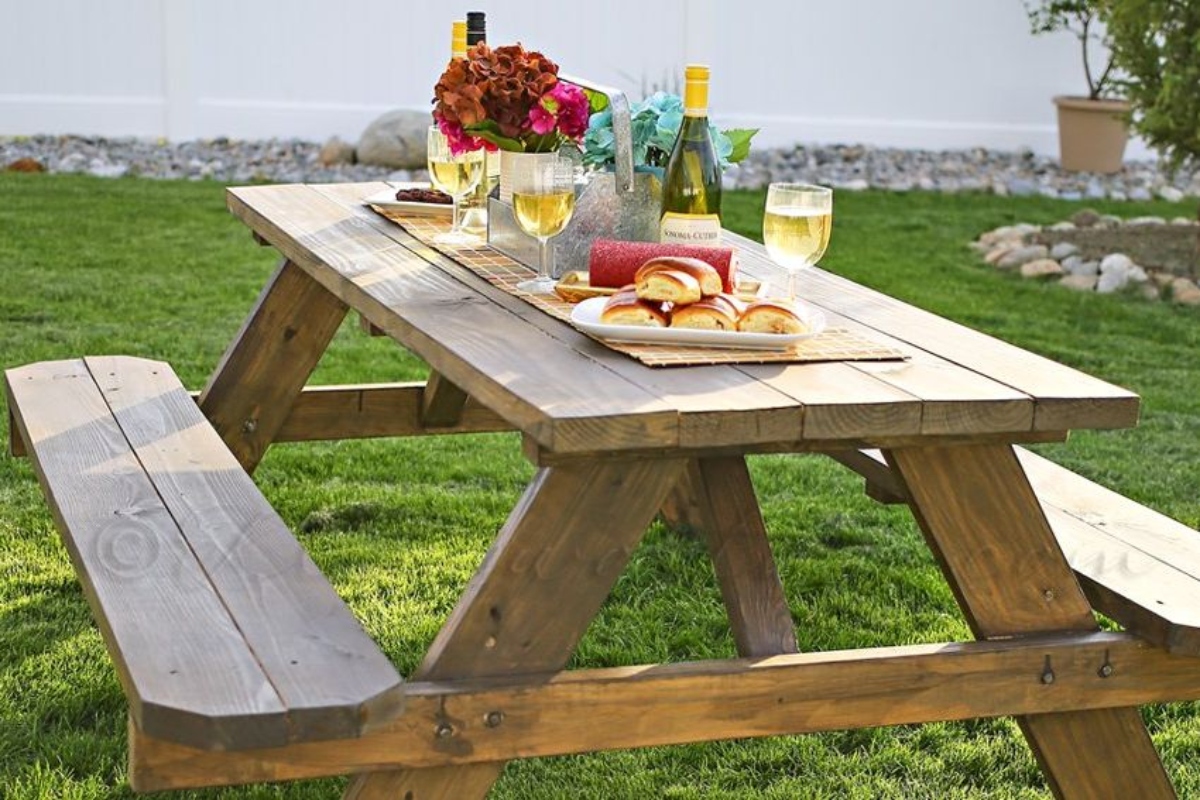Picnic benches, with their rustic appeal and practical design, have long been synonymous with outdoor gatherings, family picnics, and leisurely moments spent in nature. These versatile pieces of outdoor furniture are more than just seating; they are a focal point for communal dining, socializing, and enjoying the great outdoors. In this exploration, we delve into the world of the picnic bench, examining its designs, materials, placement considerations, and the timeless allure it brings to outdoor spaces.
Interested in gardening furniture, learn about Outdoor Bistro Sets.
Designs and Styles of Picnic Benches
Picnic benches, with their quintessential charm, evoke images of outdoor gatherings, laughter, and shared meals in the open air. The diverse designs and styles available cater to various preferences, creating an array of options to enhance your outdoor space. In this exploration, we delve into the world of picnic bench designs, uncovering the unique characteristics and aesthetic elements that make each style distinct.
Traditional A-Frame Picnic Bench
- Description – The traditional A-frame picnic bench is an iconic design that embodies simplicity and functionality. It features a rectangular tabletop with attached benches on either side, forming an unmistakable A-shaped structure.
- Characteristics – Sturdy, straightforward, and timeless, the traditional A-frame bench is often crafted from wood, providing a classic and rustic aesthetic.
- Ideal Settings – Perfect for backyard gatherings, this style complements a variety of outdoor settings, from lush gardens to patio spaces.
Folding Picnic Bench
- Description – Folding picnic benches are good for portability and convenience. These benches typically feature a collapsible frame, making them easy to transport and store when not in use.
- Characteristics – Lightweight and practical, folding benches are often made from materials like aluminum or plastic, offering a modern and versatile seating solution.
- Ideal Settings – Ideal for picnics, camping trips, or any outdoor activities where space-saving and portability are essential.
Pub-Style Picnic Bench
- Description – Inspired by pub or beer garden seating, the pub-style picnic bench features a longer, rectangular tabletop and attached benches on either side. This design encourages a communal dining experience.
- Characteristics – Conducive to larger gatherings, pub-style benches are often made from durable materials like wood or metal, adding a touch of casual sophistication.
- Ideal Settings – Well-suited for commercial spaces, outdoor cafes, or larger backyard settings.
Picnic Bench with Backrest
- Description – Unlike traditional benches, those with backrests provide added comfort and support. This design is best for extended periods of seating, enhancing the overall ergonomic experience.
- Characteristics – Available in various materials, including wood, metal, or recycled plastic, backrest picnic benches combine style with practicality, offering a more relaxed seating option.
- Ideal Settings – Great for leisurely outdoor dining or spaces where users may appreciate additional back support.
Circular Picnic Bench
- Description – Circular or round picnic benches encircle a central table, fostering an intimate and inclusive setting. This design encourages face-to-face interactions and shared experiences.
- Characteristics – Cozy and inviting and provide a unique and aesthetically pleasing seating arrangement. Their construction material is mostly wood or metal.
- Ideal Settings – Perfect for smaller groups, these benches create a communal atmosphere, making them suitable for family gatherings or intimate outdoor dinners.
Placement Considerations
Backyard or Garden
- A picnic bench in the backyard or garden creates a welcoming outdoor space for family meals, gatherings with friends, or simply unwinding amidst nature.
- Surround the bench with lush greenery, potted plants, or string lights to enhance the ambiance.
Patio or Deck
- Placing a picnic bench on the patio or deck extends your living space outdoors, offering an al fresco dining experience.
- Consider adding outdoor cushions or pillows for extra comfort. Incorporate an umbrella or pergola for shade during sunny days.
Park or Public Spaces
- Picnic benches in public parks or recreational areas provide seating for picnickers, hikers, and those enjoying outdoor activities.
- These benches are often strategically placed near scenic views, playgrounds, or barbecue areas to enhance the overall experience.
Commercial Spaces
- Restaurants, breweries, or outdoor cafes often incorporate pub-style picnic benches to create a casual and communal dining atmosphere.
- Customize the space with outdoor heaters, lighting, or planters to elevate the overall aesthetic.
Maintenance Tips
- Regular Cleaning – Wipe down the benches regularly to remove dirt, leaves, and other debris. For wooden benches, consider cleaning and resealing or staining annually.
- Weather Protection – Use furniture covers during harsh weather conditions to protect the benches from prolonged exposure to the elements.
- Inspect for Wear – Periodically check for loose screws, splinters, or signs of wear. Tighten any loose components and address any issues promptly.
- Seasonal Storage – If possible, store folding or portable picnic benches during the off-season to prolong their lifespan and keep them in optimal condition.
- Umbrellas or Shading – Consider adding umbrellas or other shading options to protect the benches and users from direct sunlight, especially during hot summer days.
FAQs
Which materials are commonly used for picnic benches?
Common materials for picnic benches include wood (cedar, redwood, pine), metal (steel, aluminum), recycled plastic, and concrete, each offering unique aesthetics, durability, and maintenance characteristics.
Where is the best place to put a picnic bench in a backyard?
Placing a picnic bench in the backyard is ideal for creating a welcoming outdoor space for family meals and gatherings. Enhance the ambiance with greenery, potted plants, or string lights.
Why choose a circular picnic bench for outdoor seating?
Circular picnic benches provide an intimate setting for smaller groups, fostering inclusivity. They encircle a central table, creating a cozy atmosphere for shared meals and conversations.
Who designed the picnic bench?
Charles H. Nielsen of Kreischerville, New York, filed a patent application in 1903 that contains the history of the first known modern picnic table. Nielsen’s table was made to be easily folded up and transported, allowing picnickers to use it wherever they pleased.
What is the height of a picnic bench?
The distance between the ground and the top of a picnic table is typically 28 to 32 inches. The typical height of a bench is 17 to 18 inches from the ground, providing 10 to 14 inches of clearance between the bench and the tabletop. The typical adult can enter and exit the table with ease because of its regular size.
What wood are picnic benches made of?
Softwood species that are weather-resistant and readily accessible at most lumber yards include Douglas fir, Redwood, and Cedar. Because they are lightweight and incredibly durable, these are the greatest woods for picnic tables.
Conclusion
The picnic bench stands as a symbol of outdoor conviviality, offering both a practical and aesthetic contribution to outdoor spaces. The diverse designs cater to various preferences, whether you seek a classic, folding, or pub-style bench. The choice of materials, from the warmth of wood to the modern appeal of metal, allows for customization that suits your style and climate.
Placing picnic benches strategically in backyard gardens, on patios, in public parks, or at commercial establishments enhances the overall outdoor experience. With proper maintenance, these benches become enduring fixtures, inviting people to gather, dine, and create cherished memories in the great outdoors.


